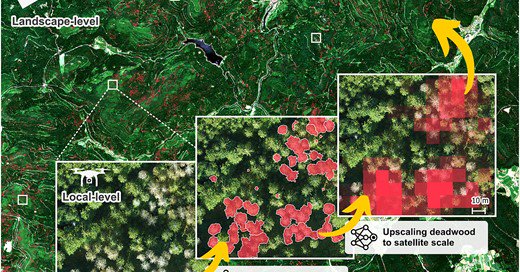
Teja Kattenborn
@TejaKattenborn
Followers
781
Following
2K
Media
99
Statuses
444
Professor for Sensor-based Geoinformatics (geosense), University of Freiburg.
Germany
Joined April 2018
Imagine one could infer the global distribution of plant functional traits from citizen science photographs…. Stop imagining it, here´s the Howto: See thread for a summary.
3
36
121
We are currently expanding the temporal and spatial coverage of our tree mortality products (towards global scales). Checkout Looking forward to your collaboration! 🧑🤝🧑🌐🌳🌲. (4/4). @MixedForests @UniFreiburg @Tree_Mortality @KIT_IfGG_Veg @kit
0
1
0
New publication: Schiefer "Large-scale remote sensing reveals that tree mortality in Germany appears to be greater than previously expected". Felix Schiefer, Sebastian Schmidtlein, Henrik Hartmann, Florian Schnabel , Teja Kattenborn. (1/4).
academic.oup.com
Abstract. Global warming poses a major threat to forests and events of increased tree mortality are observed globally. Studying tree mortality often relies
1
3
6
RT @dmlmont: 🚀 Excited to share our latest paper, "Earth System Data Cubes: Avenues for Advancing Earth System Research", just published in….
0
15
0
Interested in tree mortality dynamics? Join our session at #EGU2025. Looking forward seeing many great contributions on this timely topic!.
0
1
9
RT @BioMirela: 📢Data call! Your work could be the next dot on our global map! .Join us in this🌍initiative to map tree species! .Choose a li….
0
30
0
More info on our mission is available here: Thanks to everyone that already contributed data 🙏.
biorxiv.org
Excessive tree mortality is a global concern and remains poorly understood as it is a complex phenomenon. We lack global and temporally continuous coverage on tree mortality data. Ground-based...
0
0
1
RT @ClemensMosig: Checkout our preprint: - An Open-Access and Interactive Database for Centimeter-Scale Aerial Imag….
0
55
0
10/10: Want to find out more on the challenges and opportunities for #biodiversity or #ecosystem monitoring?. Find a blog post here: or read the full paper here: We are happy for collaborations along these research avenues!.
communities.springernature.com
Since the first NASA Earth observation missions, biophysical vegetation properties such as biomass and chlorophyll content have been monitored using satellites – however, often with significant...
0
0
4
5/10: Based on this, we calculated 124 vegetation indices that are frequently used in vegetation assessments (this was only possible with the amazing Spyndex-package of @dmlmont:
1
0
2
4/10: Using #AngleCam, we tracked the vertical leaf angle distribution of 10 temperature tree species over an entire vegetation period. The resulting leaf angle distributions were then used to simulate satellite-based vegetation reflectance of the 10 tree species.
1
0
2
3/10: So far, we could not assess the effect of leaf angle dynamics on satellite signals, because we had no efficient way to track the angles over time. Since recently, we can use #AngleCam, a computer vision method to derive leaf angles from videos.
github.com
A deep learning-based method to infer leaf angle variation from photographs. - tejakattenborn/AngleCAM
1
0
3















